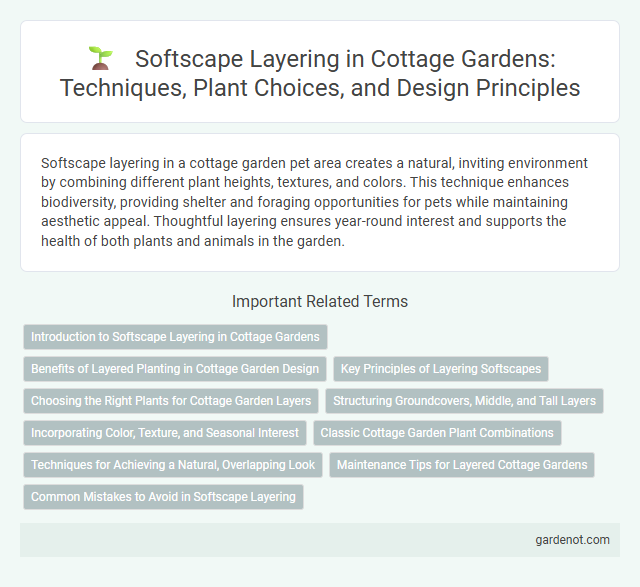Softscape layering in a cottage garden pet area creates a natural, inviting environment by combining different plant heights, textures, and colors. This technique enhances biodiversity, providing shelter and foraging opportunities for pets while maintaining aesthetic appeal. Thoughtful layering ensures year-round interest and supports the health of both plants and animals in the garden.
Introduction to Softscape Layering in Cottage Gardens
Softscape layering in cottage gardens involves arranging plants in tiered formations to create depth, texture, and seasonal interest. Key components include groundcovers, mid-height perennials, and taller climbers or shrubs, which work together to replicate the garden's natural, informal charm. This technique enhances biodiversity and visual appeal by combining diverse plant species that thrive in the softscape environment.
Benefits of Layered Planting in Cottage Garden Design
Layered planting in cottage garden design enhances biodiversity by combining various plant heights and textures, creating habitats for pollinators and beneficial insects. This softscape layering improves soil health through diverse root systems that aid in moisture retention and nutrient cycling. The visual depth achieved by layering also provides year-round interest and natural weed suppression, promoting a resilient and sustainable garden ecosystem.
Key Principles of Layering Softscapes
Softscape layering in a cottage garden relies on key principles such as diversity, texture, and height variation to create an inviting, naturalistic feel. Strategically combining ground covers, perennials, shrubs, and climbers ensures continuous bloom, seasonal interest, and structural balance. Emphasizing native plants and organic shapes enhances biodiversity and fosters a thriving ecosystem within the garden.
Choosing the Right Plants for Cottage Garden Layers
Selecting the right plants for cottage garden layers involves combining various textures, colors, and heights to create a rich, naturalistic appeal. Incorporate a mix of ground covers, mid-height perennials, and taller shrubs or climbers to establish depth and seasonal interest. Prioritize native and pollinator-friendly species like lavender, foxglove, and sweet pea to enhance biodiversity and maintain harmonious growth.
Structuring Groundcovers, Middle, and Tall Layers
In a cottage garden, effective softscape layering begins with groundcovers such as creeping thyme and ajuga, which create a dense, textured carpet that suppresses weeds and retains soil moisture. The middle layer incorporates herbaceous perennials like foxgloves and lavender, adding vibrant color and attracting pollinators while maintaining a natural flow. Tall plants like hollyhocks and flowering spires of delphiniums provide vertical interest and structural height, forming an inviting, multi-dimensional garden landscape.
Incorporating Color, Texture, and Seasonal Interest
Softscape layering in a cottage garden emphasizes the harmonious blend of color, texture, and seasonal interest to create a dynamic, inviting space. Diverse plant species such as lavender, foxglove, and roses provide varying hues and textures, enhancing visual depth throughout the year. Incorporating evergreen shrubs and perennial blooms ensures continuous seasonal appeal, enriching the garden's overall aesthetic and sensory experience.
Classic Cottage Garden Plant Combinations
Classic cottage garden plant combinations thrive through softscape layering that balances height, texture, and bloom time. Tall foxgloves and delphiniums provide vertical structure, while mid-tier lavender and catmint create fragrant, colorful mass. Ground-level creeping thyme and alyssum fill gaps with delicate foliage and continuous blossoms, enhancing the garden's lush, timeless appeal.
Techniques for Achieving a Natural, Overlapping Look
Softscape layering in a cottage garden relies on planting techniques that create a natural, overlapping effect by combining varying heights, textures, and bloom times. Using groundcovers, perennials, and shrubs in staggered arrangements promotes visual depth, while allowing plants to intermingle freely mimics natural growth patterns. Emphasizing drifts of color and repeated plant groupings enhances the garden's cohesive yet informal charm.
Maintenance Tips for Layered Cottage Gardens
Regular pruning and deadheading promote healthy growth in layered cottage gardens by preventing overcrowding and enhancing air circulation among softscape plants. Applying organic mulch retains soil moisture, suppresses weeds, and enriches soil fertility, crucial for sustaining dense, multi-layered plantings. Consistent monitoring for pests and diseases enables timely intervention, ensuring the vibrant, lush appearance characteristic of well-maintained cottage garden softscapes.
Common Mistakes to Avoid in Softscape Layering
Common mistakes in softscape layering for cottage gardens include overcrowding plants, which hampers airflow and increases disease risk, and neglecting plant height variation, resulting in a flat, uninspired design. Failing to consider seasonal bloom times leads to gaps in color and interest, while ignoring soil requirements can stunt growth and reduce plant health. Proper spacing, diverse plant selection, and understanding site conditions ensure a thriving, multi-dimensional softscape that enhances the cottage garden's charm.
Softscape layering Infographic

 gardenot.com
gardenot.com